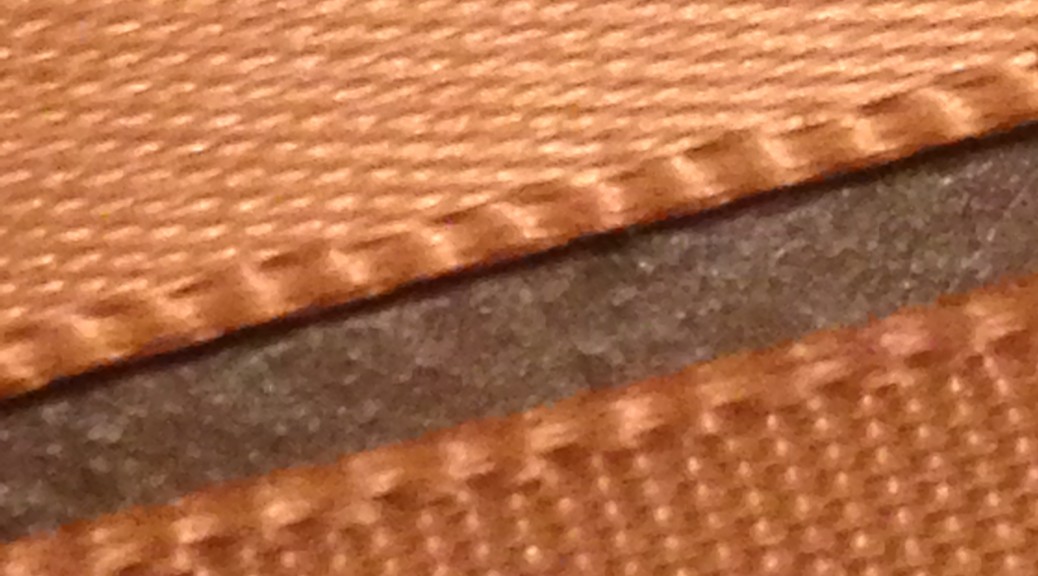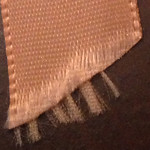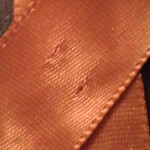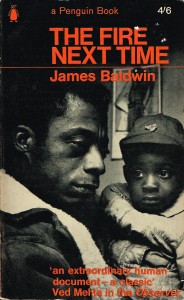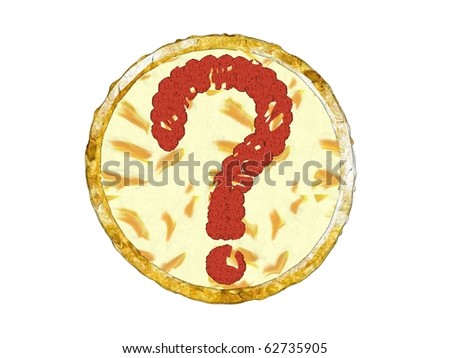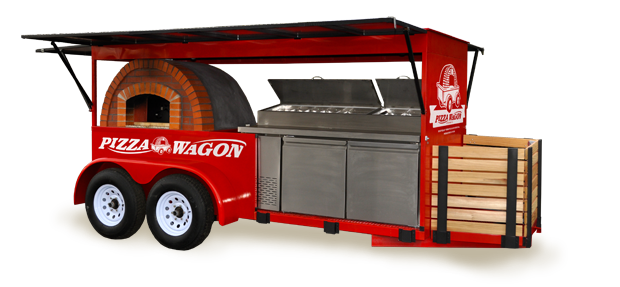The present object, at its face, has a triangular shaped side, measured at 7.6 inches tall. At the height of this measurement, the object is sectioned off by a perfectly leveled horizontal line to form a pyramid shaped portion at .3 inches tall. At the objects peak, it stands at 7.9 inches tall.
The object has 4 sides of uniform dimensions. When looking at the bottom of the object, when it is turned with it’s apex, at the pyramid shape, pointing downward, we see that the base is square shaped. Each side of the square, at the bottom of the object, measures at 4.5 inches. The slope of the triangle is roughly 101 degrees from base to apex. Its weight is measured at 330g.
The first component seen on this object is the indentation at what we can presume is the objects front. From 3.4 inches to 7.4 inches is where this indentation occurs, measured at roughly .3 inches deep into the object’s front. This indentation has a black triangular shaped finish on what appears to be treated plastic. On either side of the triangle there are groves following, perfectly, the original triangle shape of the object.
Directly down the center of this area is a metal piece. It is thin, with several grooves in it, measured perfectly starting at the bottom and occurring more rapidly as we scan its features to its top. This piece is not attached to this area, rather, if we follow is origination, and maneuver the whole object so that the apex of the triangle is pointing at us, we see a rectangular shaped hole where the object’s point of origination extends from. The rectangular hole measures about a third of the indentation in the whole object, and extends about half of the indented area’s base, centered, at 3.4 inches on the slope from the base of the object.
On the metal piece is a pitchfork shaped device with three prongs. The outer prongs of this device hug the metal piece and are thicker than the center prong, which is positioned directly on top of the metal piece. They seem to latch on to the grooves of the metal piece and the device can be moved to the desired position. The metal piece, at its very top, is housed within a ridge of the indented section. When the metal piece is removed from this housing it snaps forward from the front of the object and swings from side to side.
The final piece of the indented portion of the object is located directly underneath the metal piece. It is an additional indentation with a gray color. It extends the same height as the metal piece but is markedly wider. There are underlined numbers printed on this piece. The underlines correlate in position with the groves of the metal piece — so that the top number, 40, is underlined very close to where the first groove of the metal piece begins, when housed in the ridge, and the next number from the top, 42, correlates with the next groove of the metal piece.
Each concurrent number appears on the opposite side of the metal piece, on the final indentation, and lowered so that 40 is higher than 42, and on the left side (from our perspective) of the metal piece, while 42 is higher than 44, and on the right side of the metal piece (40 and 44 are both on the left side of the metal piece).
At the bottom of the final indentation appears to be a pitchfork shaped figure enclosed in a black diamond. Underneath the diamond is the word “Wittner,” presumably the objects maker.
The object, excluding the indentation mentioned previously, appears to be made of a mahogany finish. It has several black striations from bottom to top and resembles a wood finish. The finish reveals itself to be a hard plastic when touched and inspected further. On the the object’s left side, if we presume the indented area is the front, there is a metal knob that clicks on hinges in the interior of the object, in an area that, to be inspected, would require dismantling the entire object to view. This knob, presumably, winds up the metal piece in the indentation, and when it is wound, the metal piece swings at different rates, depending on the position of the pitchfork shaped device on the ridges on the metal piece.
The higher the pitchfork shaped device is, the slower it swings — so that 208, the number lowest on the final indentation, swings the metal piece faster than 40, the number highest on the final indentation. Whenever the metal piece crosses the center, where it is housed, it makes a clicking noise. These clicks can be timed, when maneuvering the pitchfork device, to match up with the second hand of a clock — or faster and slower.
The final piece we will inspect is the “Wittner” inscription on the final indention, underneath the diamond shape. A quick internet search yields some results, Wittner is a german manufacturing company that specifies in various musical auxiliary equipment. Our object turns out to be a Wittner made metronome Model No. 812 K, plastic coating.
This object is not specific to the maker Wittner. Johann Maelzel is one of the early, questionable, inventors of the modern metronome, and the design of early model components are accredited to Galileo, who discovered the practical uses of a pendulum swing.
Maelzel’s story ties in closely with Beethoven’s composition of the Battle Symphony, where Maelzel requested a piece be written to be performed on another contraption of his, the panharmonicon. But after a bitter battle with the composer over the ownership of the piece, Maelzel, while on a world tour, died aboard the Otis in travel from Havana to Philadelphia, but his contribution lasted.
Despite Maelzel’s German lineage, the term Metronome actually comes from Greek. It is a combination of the words Metron (measure) and Nomos (relegating). Whether the ancient Greeks had any notion of developing a metronome predating Maelzel’s model is unknown, but history shows them as users of water clocks.
Water clocks are early time keeping devices that originated in Egypt around two thousand B.C.. These clocks were powered by a water supply, that, when emptied into a reservoir, lifted a floating device that was attached to handle. This handle, attached to a gear above it, would rise as water filled the reservoir, and turn the gear which controlled the movement of a clock dial. When the water in the supply container ran dry, and the reservoir was filled, the clock would stop and both devices would have to be restored to normal. This design required constant manipulation to the ancient Greeks, but with Obelisks only being readable during daylight hours, the water clock was an efficient substitute.
These water clocks of ancient Egypt and Greece begot innovation in the centuries following that led to the invention of the clock, as we know it, and the Wittner metronome Model No. 812 K, plastic coating.
This particular metronome was used during the composition of an alto saxaphone and piano piece that won first prize at the 2011 Ohio Federation of Music Clubs’ Composition Competition collegiate level. The young man who won the competition began playing the piano at thirteen years of age. During his artistic infancy, he practiced fourteen hours a day, measuring his notes and discerning the distinct taste the staccato and legato flavor a piece. His daily schedule deferred to his practice schedule and he committed to the precedent routine with short naps throughout the day supplementing the lack of major REM sleep. This schedule would change depending on what time his bus, provided by the local public school system, would carry him to his middle and high school classes. At first he learned pieces of music by ear, playing crude renditions of Handel and fumbling through advanced chord progressions for those of the likes of Thelonious Monk.
He exhibited a singular interest in classical and blues music that distinguished himself among his peers. His appetite for the thrill of practicing, however raw, lead him to pursue a richer knowledge of the artistry of composition and arrangement. At fifteen years old he got his first piano instructor who would refine his artistic capabilities. On tuesdays and thursdays, at seven o’clock, he would meet with his instructor to develop his ability to read measures of sheet music. The instructor was captivated by the student’s quick knowledge and measured understanding of the classics.
He was advised, after a short period, by the instructor to seek a more advanced instructor. That year, during his first semester of tenth grade, he heeded his former instructor’s advice and he went on to study under a master class instructor who, over the progression of her advisements, would suffer bouts of disorientation and forgetfulness that accompanied her dementia. Nevertheless, the relationship was a fruitful one and the student decided to attend Shorter University in Rome, Georgia (the city’s name commemorates the Italian city with the same name) in remote appreciation of Italian composer, Antonio Vivaldi.
The student performed well under the tuition of his professors at Shorter, and he graduated three years after he first entered the program. He amassed a comprehensive repertoire with works ranging from early classical to later twentieth century, and many of his own compositions (some of which he entered into competition and won). He then went on to pursue his master’s degree at Cincinnati Conservatory of Music after studying in Austria, the “capital of classical music,” and he’d learned on his trip that he focus should be on composition. There, in his second and final year at CCM, he wrote the piece that would win him the 2011 Ohio Federation of Music Clubs’ Composition Competition collegiate level, and placed him in an excellent position to pursue his DMA at Cornell University in Ithaca, New York, and after his sojourn in this city named after Odyssey’s refuge there is no way of knowing what direction his journey will take him.
The metronome was attendant in much of his journey, from Rome, Georgia, to Austria; from Cincinnati to Ithaca, and It was used to aide in the preparation of many pieces before garnering the mentioned win. Prior to its current ownership, it was shipped from Allgäu, Germany, Wittner’s shipping address.
If this metronome will ever be encased in glass, like Beethoven’s famed metronome, from his house in Baden, Austria, is too early to know, but there are millions of metronomes in use today measuring the practice of aspiring, and accomplished, musicians.
The most recent metronomic devices are digital and many can be used from the internet. They range from the traditionally standard (ranging from 40 to 208 beats per minute [bpm]) to the technologically advanced digital interfaces that measure time at 900bpms.
Various measures of time are useful to what flavor of music is being created. From the 72bpm in “Kaneda’s Death, Pt.2 (Adagio in D minor)” from the 2007 science fiction film Sunshine, to the 140bpms in Beyonce’s “Drunk in Love,” to the faster 380bpm, at its peak, in John Coltrane’s “Giant steps.” The disparity in tempo can be culture and genre specific and can provide abstract insight on the culture attributed to them (disco music in the 1970s usually has a faster tempo than 17th century baroque music).
The metronome simply measures time and a key component of many traditional metronomes is the pendulum. The pendulum is a thin metal piece that swings and ticks as it crosses the center line of the metronome. It was initially developed by Galileo Galilei in the early 17th century, and its full functionality came later that century with the invention of the pendulum clock by Christiaan Huygens. Galileo played a major role in scientific revolution during the European Renaissance, a movement that was concerned with ordering the nature.
The clock maintains its basic function, as it has since prehistoric Egypt, with their invention of the obelisk, and that is to track time.
Although the ancient obelisk were designed to designate time for the early egyptians to farm, our present mode of life is not disparate from their ideas of raising grain during their most productive hours. We maintain a forty-hour work week; a scheduled time in which a train arrives, or leaves; we maintain our children’s bedtime, or our own bedtime, and bedtime stories; we maintain daylight savings time, and innumerable ways to track our time. Many contracts are often carefully crafted with time limitations and stipulations. Many of our laws have statutes. We even monitor our blood pressure with time, and surgeons offer an estimated time of surgery prior to operation. Time is an aspect of life we adhere to constantly without conscious effort. We order ourselves to certain schedules and are flustered when that element of our life falls to pieces–how many times do you scour the internet or repeatedly pester your coworkers and friends to gather a definite answer to whether we fall back an hour when daylight savings ends. Time is an rigid autocrat and we marshal our abilities ingratiatingly for an opportunity to compose a symphonic catalogue of how that time was spent.


